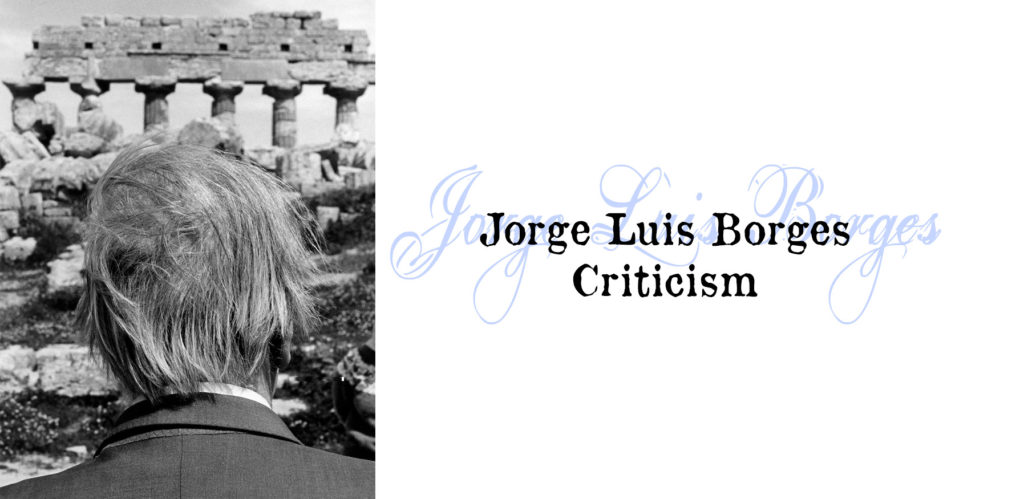Borges Criticism – Scientific
- At August 29, 2019
- By Great Quail
- In Borges
 0
0
There is a concept which corrupts and upsets all others. I refer not to Evil, whose limited realm is that of ethics; I refer to the infinite.
—Jorge Luis Borges, “Avatars of the Tortoise.”
Borges Criticism: Scientific Criticism
This page collects English-language Borges criticism with a focus on science, mathematics, and technology. This includes artificial intelligence, “posthuman” studies, and cybernetics. (A complete list of Borges Criticism can be accessed at the bottom of the page.) The books are listed in chronological order of publication. Clicking the image of a book takes you directly to Amazon.com. Wherever possible, links to the Internet Archive are provided. These “online editions” may or may not match the exact edition of the corresponding book.
Each book contains a brief description and a summary of its contents. Some have also been reviewed. If any knowledgable visitor would like to submit comments for any of the “unreviewed” works, please contact the Garden!
Borges and Artificial Intelligence
An Analysis in the Style of Pierre Menard
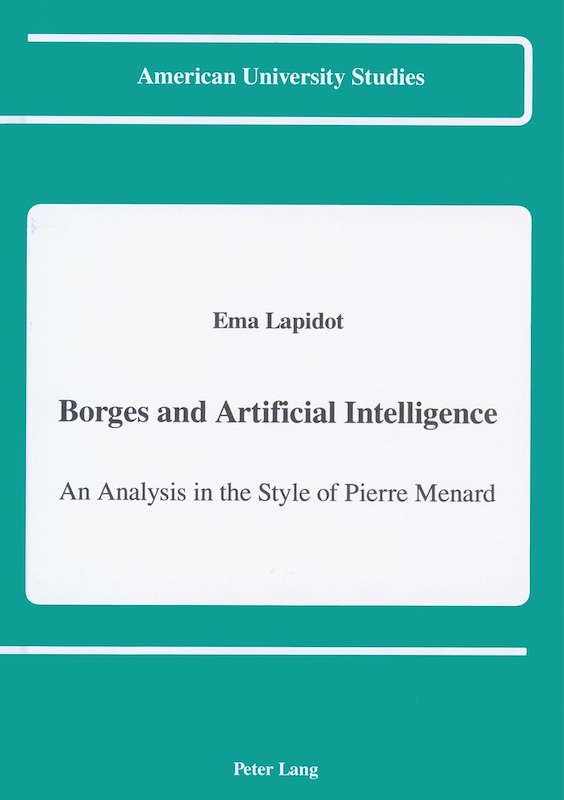 Borges and Artificial Intelligence: An Analysis in the Style of Pierre Menard By Ema Lapidot Peter Lang, 1991 |
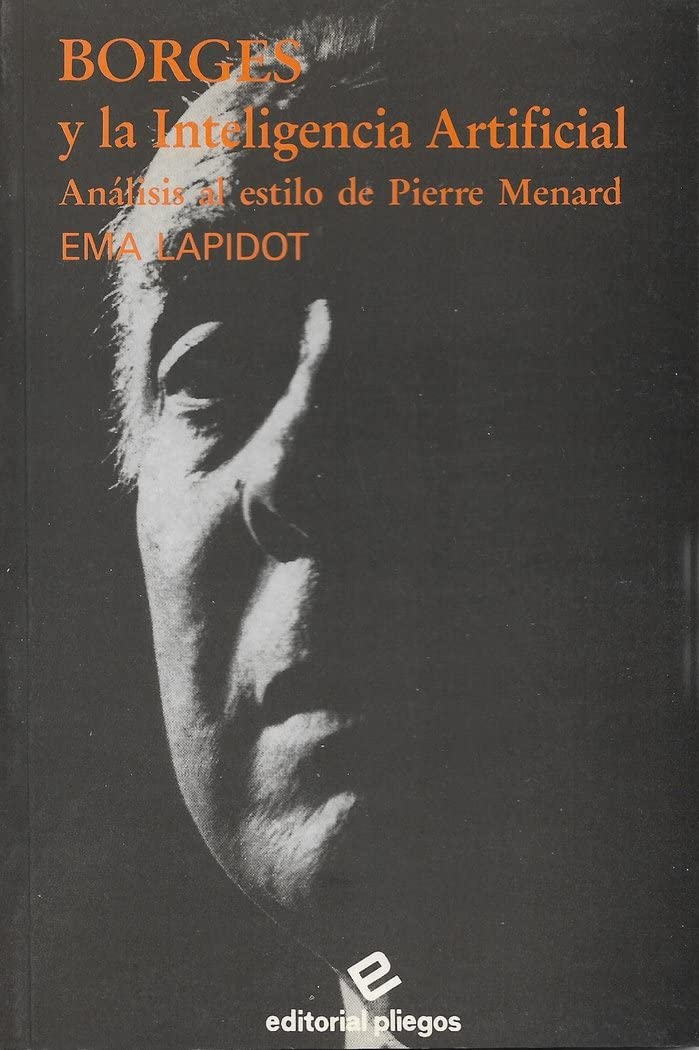 Borges y la inteligencia artificial: Análisia al estilo de Pierre Menard By Ema Lapidot Editorial Pliegos, 1990 |
Born in Argentina as Nema Feijielson, Ema Lapidot (1931–2024) moved to Israel in 1954. In 1963 she relocated to the United States and earned a Ph.D. in Spanish Literature, becoming a professor at SUNY Albany. She specialized in Latin American literature, Dutch painting, and the relationship of literature to artificial intelligence. An early study of “cybernetics,” Borges and Artificial Intelligence was published concurrently in Spanish by Editorial Pliegos as Borges y la inteligencia artificial.
Publisher’s Description: This book analyzes the tight weave between literature and science found in Borges’ writings. Of the many aspects of scientific thought found in Borges’ work, Artificial Intelligence is one even though the author was not aware of the existence of this technology. Borges discusses explicitly the mechanization of thoughts in some of his essays. Drawing on Borges’ idea that it is the reader, and not the writer, who sets the meaning on a text, a contemporary reader finds that many concepts of AI technology are implicit in his short stories, ideas such as “hardware,” “software,” “memory,” “program” and “programmer,” “data,” and so on. His essential skepticism echoes the skeptics of present-day AI scientists.
Reviews: Gustavo Fares’ review of Borges and Artificial Intelligence was published in Chasqui, Vol. 24, No. 2 (Nov. 1995): pp. 138–144, [JSTOR paywall].
Unthinking Thinking
Jorge Luis Borges, Mathematics and the New Physics
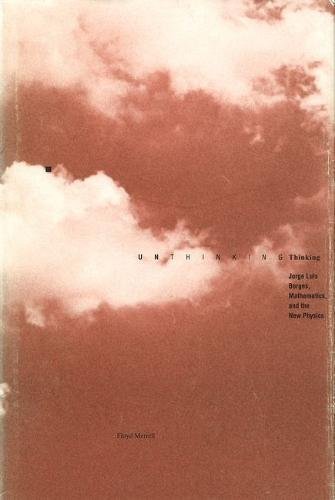
Unthinking Thinking: Jorge Luis Borges, Mathematics and the New Physics
By Floyd Merrell
Purdue University Press, 1991
Online at: Internet Archive
A prolific scholar of Latin American literature with a background in chemistry and physics, Floyd Merrell is an Emeritus Professor at Purdue University. Many of his works on Borges revolve around science and mathematics, and his papers bear wonderfully intriguing titles such as “Borges and Early Quantum Labyrinths” or “Borges and the Fourth Dimension.”
Publisher’s Description: This authoritative study explores the scientific and mathematical cultural milieu that patterns much of the Argentine writer Jorge Luis Borges’s narrative design. Although criticism of Borges’s fiction and essays has long emphasized philosophical traditions, Merrell expands the context of this interrogation of traditions by revealing how early twentieth-century and contemporary mathematics and physics also participated in a similar exploration. Topics treated include the semiotic flows of paradox and contradiction, the patterns of infinities, the limits of natural and mathematical languages, and the narrative function in scientific theory. Against this, background, Merrell provides incisive readings of Borges’s complex fiction and essays.
Table of Contents:
Key to Quotes from Borges’s Works
Preface
Acknowledgments
Chapter One: Intellection and Contemplation: An Impossible Coniunctionis Oppositorum
1. Metaphysics of Deceit
2. Where Fiction Ends
Chapter Two: A Predilection for Paradox
1. According to the Eye of the Beholder
2. To Reach the Unreachable
Chapter Three: The Demise of Totalizing Quests
1. Models of Infinity
2. The End of Certainty
Interlude
1. Number Power/Word Power
2. The World as Dream
Chapter Four: The Universe as Library
1. The Fearful Sphere
2. Parmenides Triumphs
Chapter Five: Chronos in Chains
1. Time’s Eternal Struggle
2. Singularities and Other Strange Phenomena
Chapter Six: What Is Real?
1. The Most Probable World
2. A Throw of the Dice
3. Multiple “Realities”
4. Quantum—and Textual—Interconnectedness
5. Symmetries, Mirrors, Broken Symmetries
Chapter Seven: Suspended within Language
1. Language against Itself
2. The Rules of the Game
3. Texts of Our Own Making
4. The Receding Horizon
Notes
Works Cited
Index
Reviews: Gustavo Fares’ review of Borges and Artificial Intelligence was published in Chasqui, Vol. 24, No. 2 (Nov. 1995): pp. 138–144, [JSTOR paywall]. Silvia G. Dapía’s review appeared in Variaciones Borges, No. 2 (1996), [Borges Center]. She found it “a fascinating book, recommendable for its goals, scope, and knowledge of secondary material.”
Borges 2.0:
From Text to Virtual Worlds
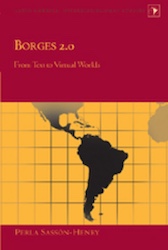
Borges 2.0: From Text to Virtual Worlds
By Perla Sassón-Henry
Peter Lang Publishing, 2007
Perla Sassón-Henry is Associate Professor at the United States Naval Academy. She is interested in “the works of Jorge Luis Borges and Latin American digital literature from the perspective of comparative studies, science, electronic literature, video games and net-art.”
Publisher’s Description: Borges 2.0: From Text to Virtual Worlds analyzes Jorge Luis Borges’s “The Library of Babel,” “The Garden of Forking Paths,” and “The Intruder” from a tripartite perspective that encompasses literature, science, and technology. This book underscores developments in chaos theory during the 1980s and their intricate connections with Borges’s works and the digital world. Without losing sight of this critical framework, this study also takes into account Deleuze and Guattari’s rhizome theory and Umberto Eco’s theory on labyrinths. Borges 2.0 is unique in its analysis of how Borgesian texts relate to science and technology at the same time that science and the virtual world illuminate Borges’s texts to provide a new reading of his work.
Table of Contents:
Prologue: Bridging the Gap
- Computers, Hypermedia, and the Humanities
- Jorge Luis Borges: A Forerunner of the Technology of the New Millennium—Links and Forking Paths
- The Significance of the Theories of Deleuze, Guattari, and Eco to Understanding Borges’s Work and Hyperfiction
- “The Library of Babel,” “The Garden of Forking Paths,” and the World Wide Web as Rhizomatic and Hypertextual Environments
- “The Library of Babel,” “The Garden of Forking Paths,” and the World Wide Web: Worlds as Mazes and Labyrinthine Nets
- Towards the Future: Bridging the Gap between Literature, Science, and Technology
- Chaosmic Libraries: Jorge Luis Borges’s “The Library of Babel” and Stuart Moulthrop’s Cybertext “Reagan Library”
- North Meets South: Jorge Luis Borges’s “The Interloper” and Natalie Bookchin’s Media Experiment The Intruder
- Epilogue: Back to the Future
Reviews: Mark Addis’ review of Borges 2.0 was published in Information, Communication & Society, Vol. 12, No. 7 (2009): pp. 1120–1121, [Taylor & Francis paywall]. J. Andrew Brown’s review appeared in Variaciones Borges No. 28 (2009), [Borges Center]. Although Brown appreciated the attention Sásson-Henry paid to hyper-textual artists, he found the book underwhelming:
Ultimately, the book is more of an affirmation of the sense that hypermedia is Borgesian than a compelling argument for why we should read it as such. A more intriguing question for this reviewer is why the perceived need exists to identify something as “Borgesian” in the first place. What is it about our readings of Borges and our readings of contemporary digital culture that compels so many to remake Borges as a hypertextual forerunner? How does this help our readings of contemporary culture and to what extent do we live in a world that Borges made (to paraphrase an essay written by Jonathan Lethem)? Much larger questions, certainly, and beyond the scope of this review.
The Unimaginable Mathematics of Borges’ Library of Babel
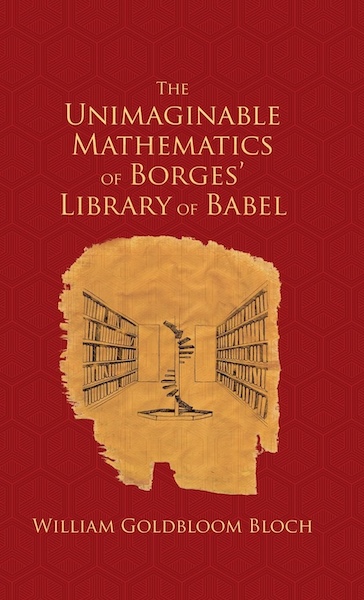
The Unimaginable Mathematics of Borges’ Library of Babel
By William Goldbloom Bloch
Oxford University Press, 20o8
Online at: T-Bag
William Goldbloom Bloch is Professor of Mathematics at Wheaton College.
Publisher’s Description: “The Library of Babel” is arguably Jorge Luis Borges’ best known story—memorialized along with Borges on an Argentine postage stamp. Now, in The Unimaginable Mathematics of Borges’ Library of Babel, William Goldbloom Bloch takes readers on a fascinating tour of the mathematical ideas hidden within one of the classic works of modern literature. Written in the vein of Douglas R. Hofstadter’s Pulitzer Prize-winning Gödel, Escher, Bach, this original and imaginative book sheds light on one of Borges’ most complex, richly layered works. Bloch begins each chapter with a mathematical idea—combinatorics, topology, geometry, information theory—followed by examples and illustrations that put flesh on the theoretical bones. In this way, he provides many fascinating insights into Borges’ Library. He explains, for instance, a straightforward way to calculate how many books are in the Library—an easily notated but literally unimaginable number—and also shows that, if each book were the size of a grain of sand, the entire universe could only hold a fraction of the books in the Library. Indeed, if each book were the size of a proton, our universe would still not be big enough to hold anywhere near all the books.
Table of Contents:
Preface
Introduction
Combinatorics: Contemplating Variations of the 23 Letter
Topology and Cosmology: The Universe (Which Others Call the Library)
Information Theory: Cataloging the Collection
Geometry and Graph Theory: Ambiguity and Access
Real Analysis: The Book of Sand
More Combinatorics: Disorderings into Order
A Homomorphism: Structure into Meaning
Critical Points
Openings
Acknowledgements
Appendix I. The Logos of Logarithms
Appendix II. Flat-Out Disoriented
Appendix III. Peeling the 3-Sphere
Appendix IV. A Labyrinth, not a Maze
Appendix V. An Example of the Ars Combinatoria
Bibliography
Reviews: Dan King’s review of The Unimaginable Mathematics of Borges’ Library of Babel was published in The College Mathematics Journal, Vol. 41, No. 5 (November 2010): pp. 416–418, [JSTOR paywall]. Alberto Manguel’s review appeared in the New York Sun, 23 November 2008, [NYS Archive]. The Complete Review also ran a review, finding it “decent mathematical overview, if not quite Borgesian enough.” Curtis Tuckey discusses Bloch’s book in his essay, “The Imaginative Mathematics of Bloch’s Unimaginable Mathematics of Borges’ Library of Babel” for the Cigar Society of Chicago.
Cy-Borges
Memories of the Posthuman in the Work of Jorge Luis Borges
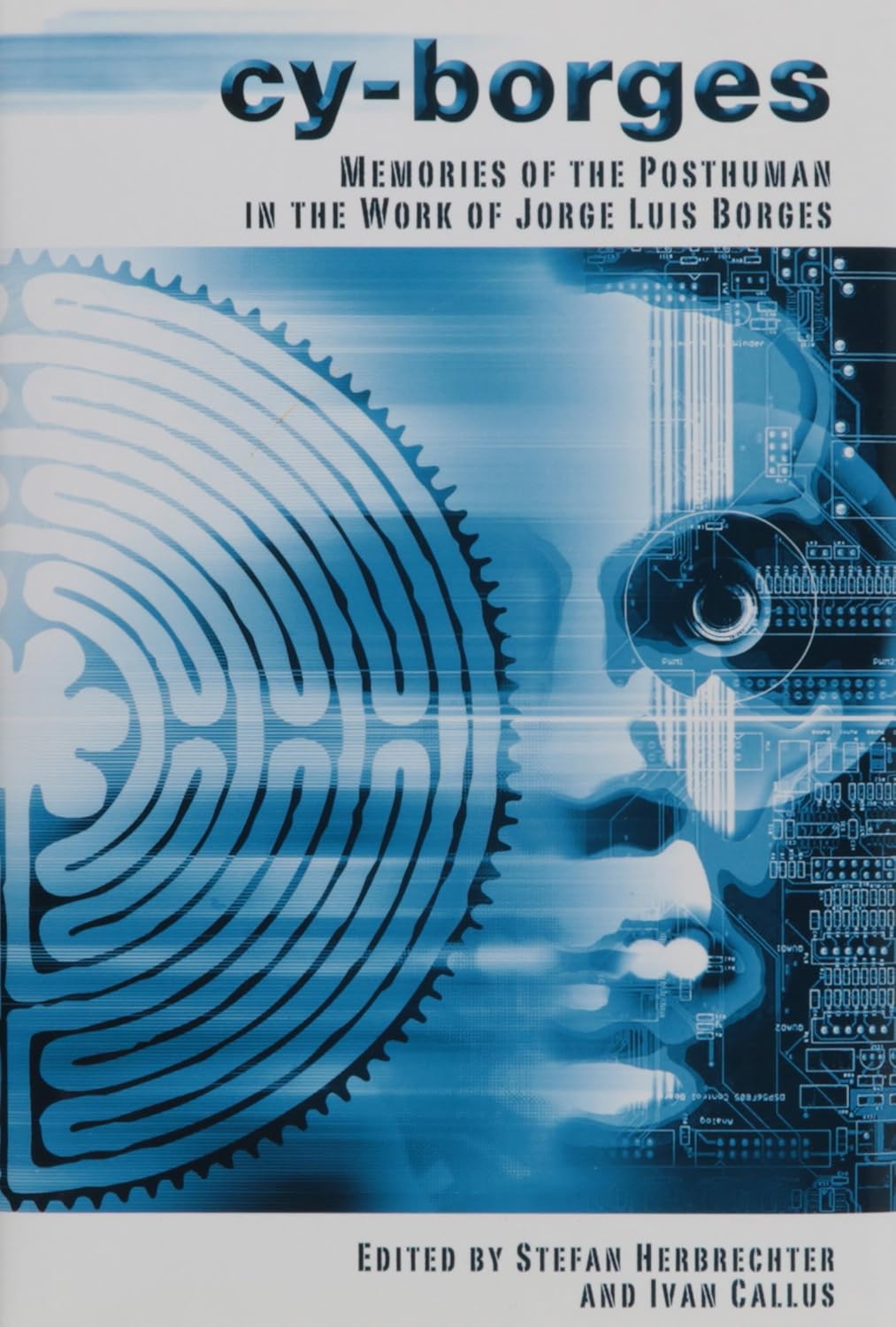
Cy-Borges: Memories of the Posthuman in the Work of Jorge Luis Borges
Edited by Ivan Callus and Stefan Herbrechter
Bucknell University Press, 2009
This unique book is edited by Ivan Callus, author of several noted works on poststructuralism, deconstruction, contemporary fiction, and posthumanism; and Stefan Herbrechter, a co-director of the Critical Posthumanism Network. A good idea of what the reader may expect can be gleaned from the jacket description, written by postcolonial critic Iain Chambers:
When the poetical mutates into the prosthetical the curvature of an unsuspected time can transport us into the archives of the future. In the memory of what is yet to come, the unsettling encounter of the writing of Jorge Luis Borges and the posthumanist immanence of the cyborg revisits and redirects the very language of criticism and philosophy. What allows the ‘human’ to appear and refract a sovereign subjectivity is here justly rendered a ruin. In writing up and recodifying ‘reason’ after ‘man’ and meta-physics, both Borges and the cyborg not only challenge the predicated banality of ‘ordinary’ life, but, push it out of joint, undo its telos, and make it homeless. A future that recalls an ambivalent past, a series of forking paths, the circular itineraries of language, returns to interrupt the present. Forever taking leave, thinking at the edge of time, this fascinating collection of essays allows us to begin to engage with the impossibilities that make us what we ‘are.’
If you are not the type of reader to trust a blurb that requires your spellchecker to learn several neologisms and places quotations around the word “are,” perhaps the publisher’s description will make more sense:
Cy-Borges—this compound word seems almost destined. It allows the associations of cyber—and cyborg to converge around the name of Jorge Luis Borges, many of whose writings are strangely prescient thought-experiments in the impossible and the unconfigurable. For though Borges speaks scantily of technology and hardly at all of the cyber-cultural futures that make it possible, his speculative fictions and other prose writings contrive glimpses of posthuman conditions that are more typically associated with writers like William Gibson and Philip K. Dick or films like Blade Runner and The Matrix. Yet the posthuman, as that which reconfigures the actual and the possible once technology re-engineers human potential and institutes a new physics, is everywhere in Borges. As this collection shows through a series of close readings of his work, Borges is therefore the precursor whom posthumanism would have had to invent had he not existed.
Table of Contents:
- Stefan Herbrechter and Ivan Callus, “Introduction: Did Someone Say ‘Cy-Borges’?”
- Floyd Merrell, “Borges: Post- or Transhuman?”
- Neil Badmington, “Babelation”
- David Ciccoricco, “Borges, Technology, and the Same Infinite Substance as the Night”
- Gordon Calleja, “Of Mirrors, Encyclopedias, and the Virtual”
- Ruben Borg, “Surviving in Borges, or, the Memory of Objects after the End of the World”
- Jonathan Boulter, “Borges and the Trauma of Posthuman History.”
- Martin S. Watson, “Archival Imaginings”
- Jean-Michel Rabaté, “Borges Canny Laughter: ‘a joyce for ever’”
- Paula Rabinowitz, “The Abysmal Problem of Time: Dubbing Borges’s Garden”
- Ivan Callus, “The Unrelated Future: Borges, Posthumanism, and the Temptations of Analogy.”
Reviews: The Garden of Forking Paths has a full review of Cy-Borges available in the “Borges Reviews” section. J. Andrew Brown’s review was published in Variaciones Borges No. 28 (2009), [Borges Center]. Héctor Hoyos’ review appeared in Comparative Literature Studies, Vol. 48, No. 4 (2011): pp. 593–596, [Project MUSE paywall].
Borges and Space
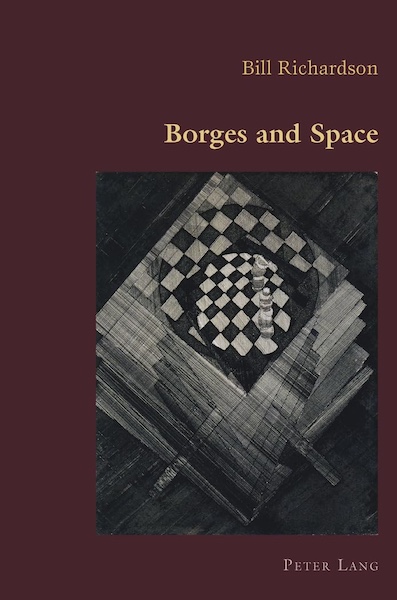
Borges and Space
By Bill Richardson
Peter Lang Publishing, 2012
Online at: Tolino [Preview only]
Bill Richardson is Professor of Spanish at the National University of Ireland, Galway. His areas of interest include the Spanish language, translation and linguistics, contemporary Spanish society, modern Spanish and Latin American authors, and “the study of literary and linguistic issues of relevance to space and deictic reference in Spanish.”
Publisher’s Description: This book examines the relevance of the concepts of space and place to the work of Jorge Luis Borges. The core of the book is a series of readings of key Borges texts viewed from the perspective of human spatiality. Issues that arise include the dichotomy between “lived space” and abstract mapping, the relevance of a “sense of place” to Borges’s work, the impact of place on identity, the importance of context to our sense of who we are, the role played by space and place in the exercise of power, and the ways in which certain of Borges’s stories invite us to reflect on our “place in the universe.” In the course of this discussion, crucial questions about the interpretation of the Argentine author’s work are addressed and some important issues that have largely been overlooked are considered. The book begins by outlining cross-disciplinary discussions of space and place and their impact on the study of literature and concludes with a theoretical reflection on approaches to the issue of space in Borges, extrapolating points of relevance to the theme of literary spatiality generally.
Table of Contents:
Acknowledgements
Introduction
Chapter 1: Aleph
Chapter 2: City
• Poetry and Cityscape
• Death, a Compass and Human Spatiality
• Immortality and the Timeless City
Chapter 3: Deixis
• Deixis and Space
• The Warrior and the Englishwoman Change Sides
• Location, Death, and the Labyrinth of Ibn-Ḥakam
• Space, Time and Identity in the Garden of Forking Paths
Chapter 4: Identity
• We are where we are—in the South
• Argentine Locations and the Marking of Identity
Chapter 5: Power
• Representational Space and the Magic Ruins
• The Movements of a Would-be Wizard
• Power, Powerlessness and Political Space
Chapter 6: Cosmos
• Babel and the Limits of the Universe
• Otherworldliness and Tlön
Epilogue
Notes
Bibliography
Index
Borges and Memory
Encounters with the Human Brain
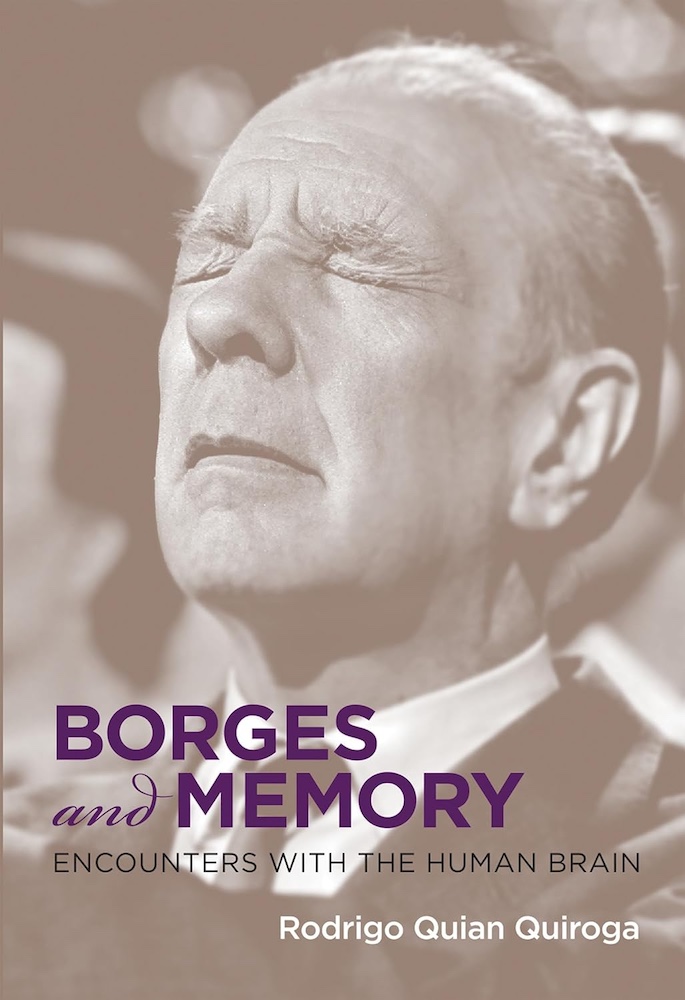
Borges and Memory: Encounters with the Human Brain
By Rodrigo Quian Quiroga
Foreword by María Kodama
Translation by Juan Pablo Fernández
MIT Press, 2012
Online at: Internet Archive
Born in Argentina, Rodrigo Quian Quiroga occupies the Research Chair at the University of Leicester, UK. He is the director of the Centre for Systems Neuroscience, and the Head of Bioengineering at the University of Leicester.
Publisher’s Description: A scientist’s exploration of the working of memory begins with a story by Borges about a man who could not forget. Imagine the astonishment felt by neuroscientist Rodrigo Quian Quiroga when he found a fantastically precise interpretation of his research findings in a story written by the great Argentinian fabulist Jorge Luis Borges fifty years earlier. Quian Quiroga studies the workings of the brain—in particular how memory works—one of the most complex and elusive mysteries of science. He and his fellow neuroscientists have at their disposal sophisticated imaging equipment and access to information not available just twenty years ago. And yet Borges seemed to have imagined the gist of Quian Quiroga’s discoveries decades before he made them. The title character of Borges’s “Funes the Memorious” remembers everything in excruciatingly particular detail but is unable to grasp abstract ideas. Quian Quiroga found neurons in the human brain that respond to abstract concepts but ignore particular details, and, spurred by the way Borges imagined the consequences of remembering every detail but being incapable of abstraction, he began a search for the origins of Funes. Borges’s widow, María Kodama, gave him access to her husband’s personal library, and Borges’s books led Quian Quiroga to reread earlier thinkers in philosophy and psychology. He found that just as Borges had perhaps dreamed the results of Quian Quiroga’s discoveries, other thinkers—William James, Gustav Spiller, John Stuart Mill—had perhaps also dreamed a story like “Funes.” With Borges and Memory, Quian Quiroga has given us a fascinating and accessible story about the workings of the brain that the great creator of Funes would appreciate.
Table of Contents:
- Funes and Other Cases of Extraordinary Memory
- The Library of Babel
- The Man Who Could Not Forget
- Living in the Past
- Subtleties of Memory
- Where Do Memories Reside?
- Prodigious Minds
- The Delicate Balance Between Remembering and Forgetting
- Perception and Memory
- Neurophysiology of Vision
- The Jennifer Aniston Neuron
- Keys to Thought
Reviews: Jan Baetens’ review of Borges and Memory was published in MIT’s Leonardo, Vol. 46, No. 5 (2013): pp. 508–509, [Project MUSE paywall]. The opening paragraphs of the review offers a good overview of Quiroga’s project:
Contrary to what its title may suggest, this book is less an analysis of Borges’s literary treatment of how our memory works than a presentation of historical and cutting-edge research on the same subject. Borges, in other words, is not the subject of the study, but its most important rhetorical channel. It may come as a surprise that the Argentine-born and -educated neuroscientist Rodrigo Quian Quiroga did not know of “Funes the Memorious” and other famous stories by Borges when he started working on the functioning of the human brain (the author does not focus on the distinction between mind and brain, just as he does not stick to the difference between body and soul), but it makes his personal account only more vivid and intriguing. For after all, Borges’s tales, many of them from the 1940s, give as vivid a description of human memory as today’s most sophisticated visual theories and representations, even if they do it in a way that modern scientists may label definitely non-scholarly.
[…]
Quiroga’s book may not contain much new information on how neuroscientists study and represent memory nowadays, but the way in which he does it is refreshing and accessible to a very broad audience. The structure of the book is mainly chronological (it follows more or less the findings in the field since the early 19th century), but with many fascinating digressions to theoretical and philosophical issues that provide excellent new readings of some great authors such as William James, Gustav Spiller and John Stuart Mill. Quiroga is a superb storyteller who has the intelligence to make himself invisible behind the subject that he narrates. He generously foregrounds the seminal thinking of all those, in Western as well as non-Western traditions, who preceded him in the field and proves very sensitive to the unfathomable suffering that goes along with neurological dysfunctions. Moreover, he manages to establish a real dialogue with his reader not only by seducing him or her with the rhetoric and humor of his fables and anecdotes, but also with a great sense of timing and construction. Each chapter discloses a new dimension of a universe that never becomes a labyrinth of concepts and research hypotheses. Throughout the book the reader is invited to “play” with the author, who is a master in combining verbal and visual information and who helps the reader take a wonderful journey through the human mind
Borges Criticism
Main Page — Return to the Borges Criticism main page and index.
General Criticism 1 — General literary criticism and commentary written during Borges’ life, 1957–1986.
General Criticism 2 — General literary criticism and commentary written from 1987 to 1999.
General Criticism 3 — General literary criticism and commentary written from 2000 to the present.
Poetics — Criticism written about Borges’ poetry and poetics.
Comparative Criticism — Borges criticism that compares Borges with other writers or locates Borges’ work within a broader literary context such as genre fiction or Latin American Literature.
Political & Theoretical Criticism — Borges criticism with a strong political, theoretical, or philosophical component: Marxist critique, postmodernism, postcolonial studies, gender studies, queer theory, disability studies, etc.
Religious & Esoteric Criticism — Borges criticism from a religious, metaphysical, or esoteric perspective.
Author: Allen B. Ruch
Last Modified: 23 August 2024
Main Borges Page: The Garden of Forking Paths
Contact: quail(at)shipwrecklibrary(dot)com

